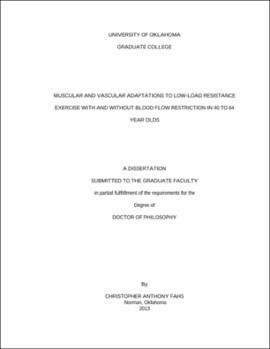| dc.description.abstract | Low-load resistance training with blood flow restriction has been shown to enhance muscular adaptations compared to work-matched low-load resistance training. However, it is unclear if low-load resistance training performed to volitional fatigue can elicit similar muscular adaptations as low-load blood flow restricted (BFR) resistance training. The vascular adaptations to low-load resistance training with and without blood flow restriction are not well characterized in middle-aged individuals. PURPOSE: To determine the muscular (muscle thickness, strength, power, and endurance) and vascular (arterial stiffness, venous compliance, resistance vessel blood flow) effects of six weeks of low-load resistance training performed to volitional fatigue with and without blood flow restriction in middle aged individuals. METHODS: Twelve men and six women completed six-weeks of unilateral knee extensor resistance training performed to volitional fatigue with and without blood flow restriction. One limb trained under blood flow restriction (BFR) and the contralateral limb trained without blood flow restriction (free flow, FF). Twice before and once after the training, measures of arterial stiffness, calf blood flow, calf venous compliance, quadriceps muscle thickness, strength, power and endurance were assessed on each limb. RESULTS: No changes in vascular function were observed throughout the study. Quadriceps muscle strength, power, and endurance increased following the training in each limb with no differences between limbs. Quadriceps muscle thickness increased in both limbs following the training but lateral quadriceps muscle thickness increased more in the limb trained under blood flow restriction. CONCLUSION: Low-load resistance training performed to volitional fatigue with and without blood flow restriction result in similar improvements in muscle function without changes in local vascular function. Low-load resistance training with blood flow restriction enhances muscle size more than low-load training without blood flow restriction. | |
